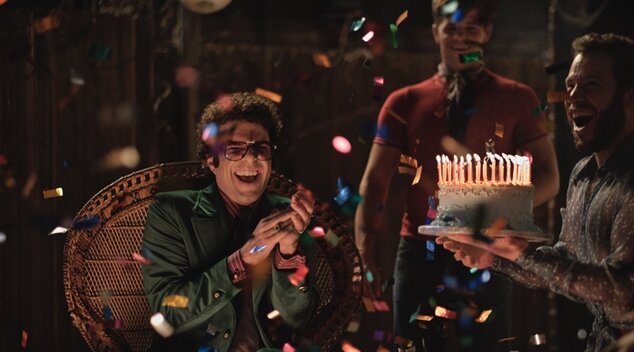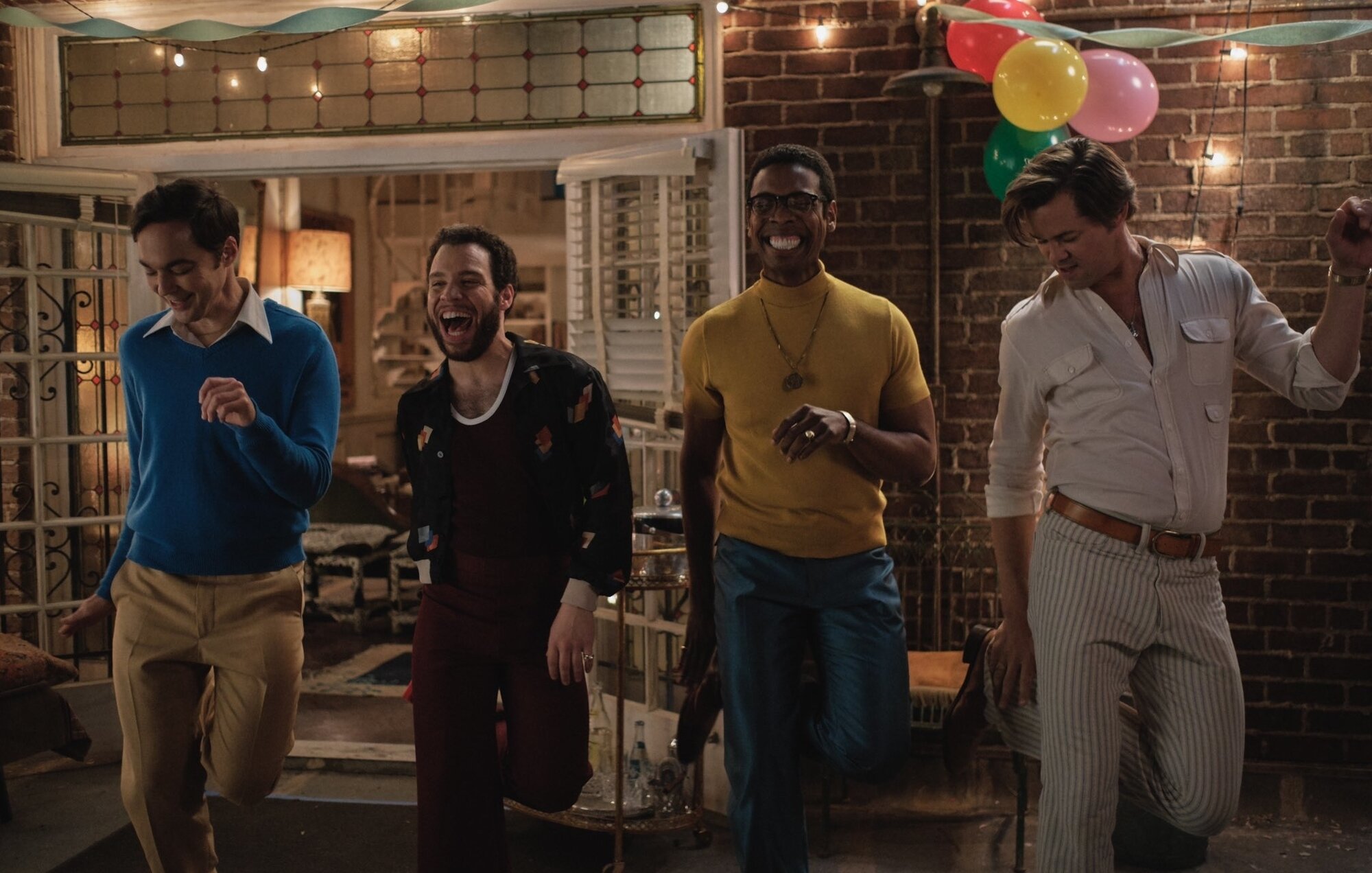“The Boys in the Band” Review: The Band Plays On In A Reverent Rendition of a 1970’s Queer Classic
Jim Parsons’ counter-charming party host throws a birthday bash straight into madness.
The exponential queering of modern media after the AIDS epidemic is a phenomena that feels more apparent as each year goes by. And though we have further yet to go in this department, it’s nice to know that the well isn’t completely dry. The conundrum, however, that appears with the presence of more contemporary queer content is a question not of abundance, but of history. Sometimes it’s easy to forget that queerness in the media existed before the 1980s. Yes, there were gays back then too. What were they up to? Well, in director Joe Mantinello’s Netflixed rendition of “The Boys in the Band” (a revival of the classic play and film) they were up to a whole lot. In the worlds of the film: “These queens are crazy”.
Under the intricately crafted script and blessing of the story’s original playwright, the late Mart Crowley, “The Boys in the Band” magnifies the lives of eight gay men (and one “straight” one) inside a flaming powder keg of a birthday party. Cordially invited guests include Donald (Matt Bomer), the group’s Jiminy Cricket conscience, the ever so effeminate Emory (Robin de Jesús), bookworm Bernard (Michael Benjamin Washington), odd couple Larry (Andrew Rannells) and Hank (Tuc Watkins), and of course, the enigmatic birthday boy himself, Harold (a permed up Zachary Quinto) and his escort rent-a-boy present played by Charlie Carver. Then there’s the matter of Alan (Brian Hutchison), a presumed straight college chum invited last minute by Michael (Jim Parsons), our snarky, self-destructive party host, whose good intentions retract into darkness as the night passes.
It’s a weighted and daring ensemble in that truly no part is larger than another, minus Matt Bomer’s biceps for obvious reasons. It is a testament to the original work that each role is so well conceived. Let’s not forget the fact that these characters are gay. For a play written in 1968, the specificity of the lives of each of these men is wonderfully nuanced, and was probably quite shocking for audiences at the time (and probably still for some today.) In regard to its queerness, this film is not shy at all, keeping the same provocative dialogue from its reclaimed derogatives to its daggered retorts. To be able to see older queer characters who are out and dealing with queer specific dilemmas is refreshing and liberating. In modern queer narratives, it feels as if a thirty year old homosexual is a unicorn. And with an all gay cast and director, the film supersedes in its authenticity. Although some may find the plot and intentions of these characters severe, there is still a cushion of comfort knowing that the creatives behind and in front of the camera know how to treat the material.
Though every performance is expertly crafted, and Mantinello’s directorial choices give the story a new visual life, it is Jim Parsons’ Michael who captains the film, the pilot of a kamikaze party plane. He gifts us with what may be his best performance post-Big Bang, translating the queer affliction of internalized homophobia into a living, breathing, ascot-wearing gumby of spite; it’s not even his party, but he’ll cry if he wants to. The original movie’s Michael, played by Kenneth Nelson, was a stinging force from the gate opening of the film. Parsons, obviously reflecting on that performance, has taken Nelson’s callousness and molded an arc for it, dipping in and out of rage, self-pity, shallowness, and happy denial. And of course, the usual Parsons whinge is kept persevered, but in “The Boys in the Band”, his affectations are weaponized, his tongue, sharpened by countless Bazingas, to be used against others and himself.
Other standouts include Tuc Watkins’ Hank, whose queerness won’t be defined by his straight-passing loafers and Robin de Jesús’ Emory, who plays a version of the tortured femboy not so manic as his original counterpart, but just as troubled. “Boys in the Band” is a piece where the ensemble cast is crucial to the film’s success; no one is more or less important-- equality for all. The bottled nature of the movie’s setting (all in Michael’s New York apartment) allows for flash-in-the-pan compact drama, and the angles at which cinematographer Bill Pope shot the film provide a balance of intimacy and breathing room for audiences. Paired with Judy Becker’s eclectic and textured production design for Michael’s showy apartment, the film grounds itself in its world.
There is a sense of reverence toward its source material strung throughout, making very little changes to the dialogue and staging of the original works. It seems as if Mantinello’s prerogative is one of preservation, not of reimagination. This year marks the 50th anniversary of the original film’s release date, and for such an important landmark in queer media, changing a formula that has worked for so many years could be distracting or even detrimental toward the intentions of the script. Some will feel that the antiquatedness of “The Boys in the Band”' is anachronistic or old-fashioned, but for those who know a good old-fashioned from a bad, this one goes down pretty smoothly.
For the first half of “Boys in the Band'', we watch our characters saunter unknowingly through a minefield, casually dancing with drinks in hand. Harold, late-as-always (even to his own birthday part), walks through the door, and immediately taps down on the first invisible bomb; his nonchalant neglect of Michael’s hard work sets off a string of fireworks. As the night continues its uproar, our bitter host continues to pry open his friends' lives like the untouched cracked crab he had specially prepared. This climaxes into the film’s most famous and longest sequence, a party game in which the rules are simple: Call the one person you truly loved. The film soars as its characters plummet into themselves. Looking back, one can presume that Michael’s surreal turning on of an endless amount of lamps and lights was only to make sure no shadow was left in the dark, and no stone was left unturned.
“The Boys in the Band'' is a retelling that welcomes everyone, but refuses to handhold. There is a specificity to these gay characters and their experiences that is overtly queer and refuses to be anything else but. The flow in and out of gay references, traumas, and jabs almost feels operatic; a story deserving of an iteration for every generation. But while distinctly queer inner conflicts are by no means a knock on the film, a question that may arise is whether non-queer audiences will be able to see all the film’s colors. Even if not, for the many who have been in the lighter loafers of these characters, there are few better renderings of the turbulent queer interior.
It’s our story, and we’ll cry if we want to.



